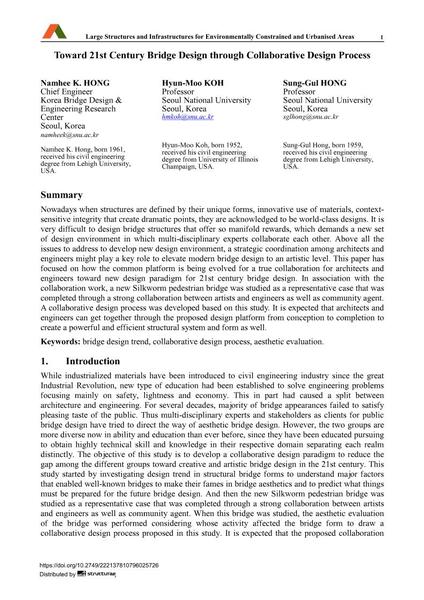Toward 21st Century Bridge Design through Collaborative Design Process

|
|
|||||||||||
Bibliographic Details
| Author(s): |
Namhee K. Hong
Hyun-Moo Koh Sung-Gul Hong |
||||
|---|---|---|---|---|---|
| Medium: | conference paper | ||||
| Language(s): | English | ||||
| Conference: | IABSE Symposium: Large Structures and Infrastructures for Environmentally Constrained and Urbanised Areas, Venice, Italy, 22-24 September 2010 | ||||
| Published in: | IABSE Symposium Venice 2010 | ||||
|
|||||
| Page(s): | 530-531 | ||||
| Total no. of pages: | 6 | ||||
| Year: | 2010 | ||||
| DOI: | 10.2749/222137810796025726 | ||||
| Abstract: |
Nowadays when structures are defined by their unique forms, innovative use of materials, context- sensitive integrity that create dramatic points, they are acknowledged to be world-class designs. It is very difficult to design bridge structures that offer so manifold rewards, which demands a new set of design environment in which multi-disciplinary experts collaborate each other. Above all the issues to address to develop new design environment, a strategic coordination among architects and engineers might play a key role to elevate modern bridge design to an artistic level. This paper has focused on how the common platform is being evolved for a true collaboration for architects and engineers toward new design paradigm for 21st century bridge design. In association with the collaboration work, a new Silkworm pedestrian bridge was studied as a representative case that was completed through a strong collaboration between artists and engineers as well as community agent. A collaborative design process was developed based on this study. It is expected that architects and engineers can get together through the proposed design platform from conception to completion to create a powerful and efficient structural system and form as well. |
||||
| Keywords: |
bridge design trend collaborative design process aesthetic evaluation
|
||||
